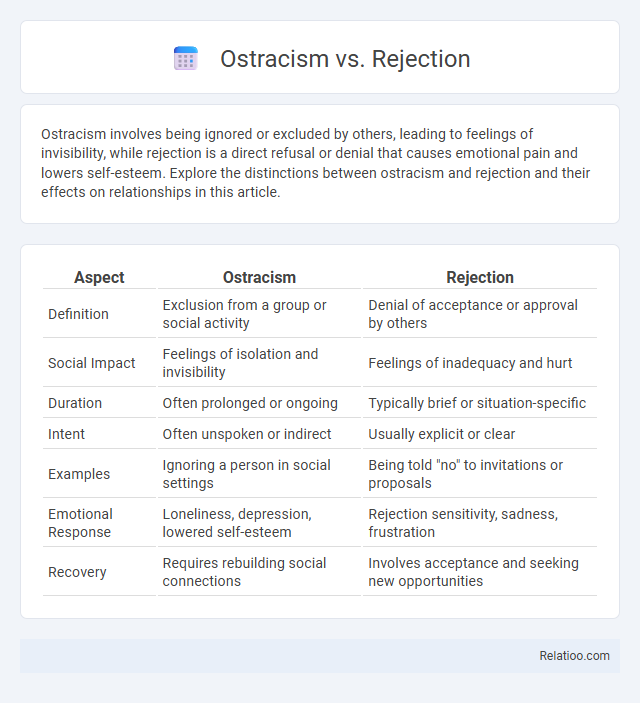Ostracism involves being ignored or excluded by others, leading to feelings of invisibility, while rejection is a direct refusal or denial that causes emotional pain and lowers self-esteem. Explore the distinctions between ostracism and rejection and their effects on relationships in this article.
Table of Comparison
| Aspect | Ostracism | Rejection |
|---|---|---|
| Definition | Exclusion from a group or social activity | Denial of acceptance or approval by others |
| Social Impact | Feelings of isolation and invisibility | Feelings of inadequacy and hurt |
| Duration | Often prolonged or ongoing | Typically brief or situation-specific |
| Intent | Often unspoken or indirect | Usually explicit or clear |
| Examples | Ignoring a person in social settings | Being told "no" to invitations or proposals |
| Emotional Response | Loneliness, depression, lowered self-esteem | Rejection sensitivity, sadness, frustration |
| Recovery | Requires rebuilding social connections | Involves acceptance and seeking new opportunities |
Understanding Ostracism: Definition and Key Features
Ostracism is the deliberate exclusion of an individual from a social group, characterized by silence, neglect, or ignoring without overt hostility. It differs from rejection, which involves explicit negative judgment or refusal, and from exclusion, which may be temporary or situational. Understanding ostracism helps you recognize its subtle impact on emotional well-being and social dynamics.
Defining Rejection: What Sets It Apart?
Rejection differs from ostracism by involving explicit denial or refusal of acceptance, often communicated directly through words or actions that convey disapproval or dismissal. While ostracism entails being ignored or excluded without direct confrontation, rejection is a clear, conscious act that signals you are unwelcome or unaccepted. Understanding this distinction helps you recognize the emotional impact and social dynamics unique to each experience.
Psychological Impact of Ostracism
Ostracism, distinct from rejection and general social exclusion, profoundly affects psychological well-being by triggering feelings of invisibility and eroding an individual's sense of belonging. Research indicates that ostracism activates neural pathways associated with physical pain, highlighting its intense emotional toll. Long-term exposure can lead to increased anxiety, depression, and impairments in social functioning, underscoring the critical need for social acceptance in mental health.
Psychological Impact of Rejection
Rejection triggers significant psychological distress, often leading to feelings of worthlessness, anxiety, and depression, as it directly assaults an individual's need for social belonging and self-esteem. Unlike ostracism, which involves social exclusion characterized by silence or ignoring, rejection involves explicit dismissal or refusal, intensifying emotional pain and cognitive rumination. Understanding the distinct psychological impacts of rejection helps in developing targeted interventions to improve mental health and resilience in social contexts.
Social Dynamics: How Ostracism Unfolds
Ostracism in social dynamics occurs through deliberate exclusion and ignoring by a group, signaling a subtle yet powerful form of social rejection that impacts an individual's sense of belonging. Unlike outright rejection, which is often explicit and direct, ostracism unfolds gradually through silent treatment and exclusion from group interactions. Understanding these distinctions is crucial for analyzing how social groups enforce norms and manage deviance through nonverbal cues and implicit social sanctions.
Social Dynamics: How Rejection Occurs
Rejection occurs in social dynamics when individuals are actively excluded or dismissed based on specific behaviors, attributes, or social norms, often leading to visible negative feedback or criticism. You experience rejection as a direct response to interpersonal interactions that signal disapproval or exclusion, contrasting with ostracism where you are ignored or neglected without explicit negative judgment. Understanding these distinctions helps clarify how social exclusion impacts emotional well-being and group cohesion.
Emotional Responses: Comparing Ostracism and Rejection
Ostracism triggers feelings of invisibility and social pain by excluding You from a group, often leading to emotional numbness and decreased self-worth. Rejection typically provokes intense feelings of personal failure, anger, and sadness because it directly targets You as an individual, challenging your value and acceptance. Both experiences cause emotional distress, but ostracism impacts social identity broadly, while rejection attacks personal acceptance on a more explicit, interpersonal level.
Coping Mechanisms for Ostracism vs. Rejection
Coping mechanisms for ostracism often involve seeking social reconnection and validation through supportive relationships or engaging in activities that rebuild self-esteem and belonging. In contrast, coping with rejection typically requires emotional regulation strategies such as cognitive reframing to challenge negative self-perceptions and fostering resilience by focusing on personal growth and future opportunities. Your ability to differentiate these approaches can enhance emotional recovery and promote healthier social integration.
Ostracism and Rejection in Relationships and Workplaces
Ostracism and rejection both involve social exclusion but differ in intent and impact; ostracism is often subtle and passive, where individuals are ignored or excluded without explicit negative judgment, whereas rejection is a direct, explicit dismissal of someone's presence or ideas. In relationships, ostracism can lead to feelings of invisibility and isolation, undermining emotional connections, while rejection triggers immediate emotional pain and challenges to self-worth. Your experience in workplaces or relationships can be profoundly affected by these dynamics, as ostracism may erode team cohesion over time and rejection can prompt defensive behaviors or withdrawal.
Prevention and Healing: Moving Beyond Exclusion
Ostracism and rejection both involve exclusion, but ostracism is a more passive form of social ignoring, while rejection is an active dismissal impacting Your emotional well-being. Prevention strategies include fostering inclusive environments and promoting open communication to reduce feelings of exclusion. Healing requires building self-esteem, seeking social support, and practicing resilience to move beyond the pain of social isolation.

Infographic: Ostracism vs Rejection
 relatioo.com
relatioo.com